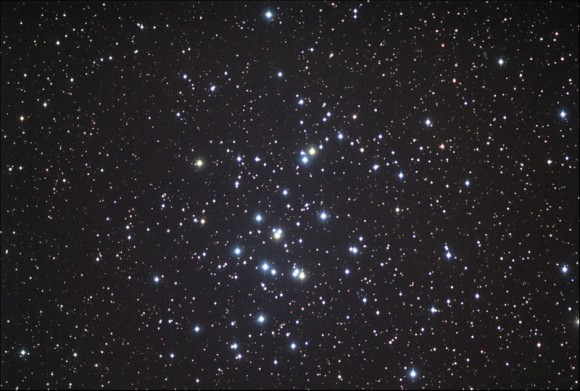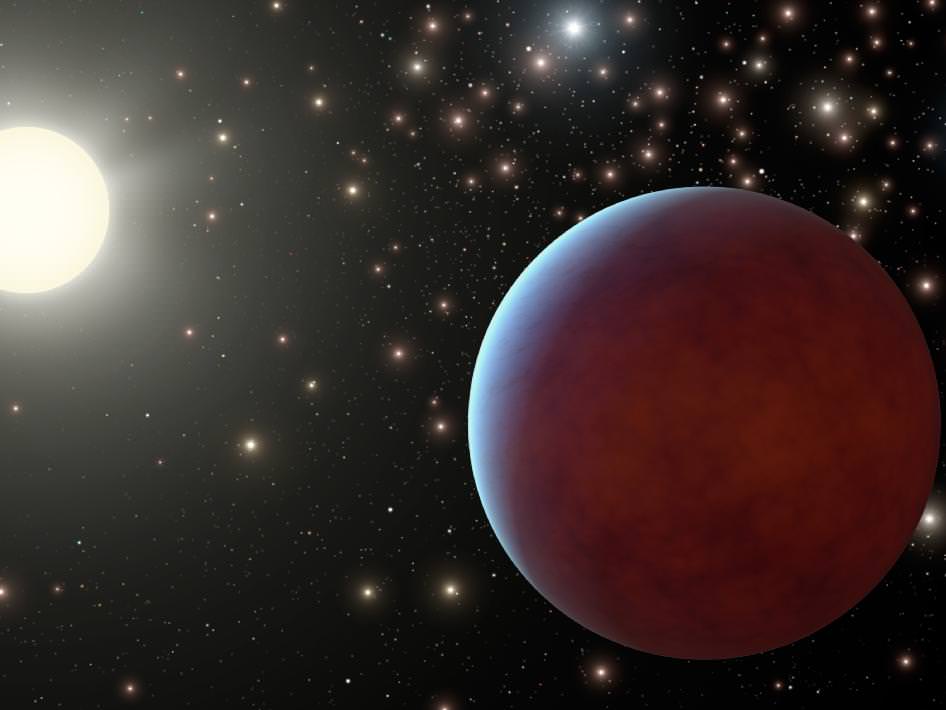Artist’s illustration of a planet within a cluster. Image credit: NASA/JPL-Caltech
There’s a classic science fiction story called Nightfall, written by the late-great Isaac Asimov. It’s the tale of a world with six suns that fill the sky with such brightness that the inhabitants have no concept of night. And then one day, a once-in-a-thousand-years alignment causes all the stars to set at once; and everyone goes crazy!
In another case of science following science fiction, NASA-funded astronomers have discovered planets orbiting within a dense cluster of stars called the Beehive Cluster; a collection of 1,000 stars collected around a common center of gravity – Nightfall worlds?!
Well, not so fast. These worlds are “hot Jupiters;” massive, boiling hot planets that orbit their parent star closer than Mercury in our own Solar System. The two new planets have been designated Pr0201b and Pr0211b after “Praesepe”, another name for the Beehive Cluster. Although they aren’t habitable, the view from those planets in a dense cluster of stars would be awe inspiring, with hundreds of stars within a radius of 12 light-years.
Astronomers had long predicted that planets should be common in star clusters. Consider that our own Solar System probably formed within a star forming complex like the Orion Nebula. Then the individual stars drifted away from each other over time, taking their planets with them. The evolution of the Beehive cluster was different, though, with the mutual gravity of the 1,000+ stars holding themselves together over hundreds of millions of years.
“We are detecting more and more planets that can thrive in diverse and extreme environments like these nearby clusters,” said Mario R. Perez, the NASA astrophysics program scientist in the Origins of Solar Systems Program. “Our galaxy contains more than 1,000 of these open clusters, which potentially can present the physical conditions for harboring many more of these giant planets.”
Until now, only two planets had been uncovered around massive stars in star clusters, but none around sun-like stars within these clusters. So the possibility of life was out of the question. These super-jupiters aren’t habitable either, but it’s possible that smaller planets will turn up in time as well.

Beehive Cluster. Image credit: Tom Bash and John Fox/Adam Block/NOAO/AURA/NSF
The planets were discovered by using the 1.5-meter Tillinghast telescope at the Smithsonian Astrophysical Observatory’s Fred Lawrence Whipple Observatory near Amado, Arizona to measure the slight gravitational wobble the orbiting planets induce upon their host stars.
This discovery might help astronomers with another mystery that has been puzzling them for a few years: how can hot Jupiters form? How can a massive planet form so close to their parent star? Instead of forming close, it’s possible that the constant gravitational interactions among stars in young clusters push planets back and forth. Some are spun out into space as rogue planets, while others spiral inward and settle into these tight orbits.
Could there be life on Earth-sized worlds within these clusters? Are there civilizations out there who have never known the concept of night?
Probably not.
According to other researchers who released their findings just a week before the Tillinghast study, planets within star clusters like the Beehive probably aren’t habitable. In a paper titled, Can habitable planets form in clustered environments?, a team of European astronomers considered the environmental effects of star clusters on the formation and evolution of planetary systems. According to their simulations, there are just too many dynamic gravitational encounters with other stars in the cluster for any planet to remain long in the habitable zone.
Source: NASA News Release


Great article, very interesting. Small nit-pick, just wanted to point out that for the planets that are discovered around stars that were not Sun-like, “the possibility of life was out of the question” is not an accurate statement.
Whether red dwarves, brown dwarves, blue giants, etc, can support Earthlike life is still very much under debate. It hasn’t been ruled out in those places.
Unless you mean the previous discoveries were around pulsars or white dwarves? In that case I would have to agree.
Globular clusters are populated with mainly PopII stars that have very low metalicity. I think it would be surprising to find a terrestrial planet around such a star.
LC
Corot and later Kepler has found that metallicity within large bounds do not affect likelihood for terrestrials, but likelihood for gas giants (Jupiters) – higher metallicities means faster disk dissipation so giants become stunted to ice giants (Neptunes).
I think the short form goes: if Jupiters can form, then terrestrials can form.
I am aware of that planets have been found around stars with low metalicities. As Magnus pointed out this is not a globular cluster, so my comment is not quite right. I do suspect that PopII stars do not frequently have planetary systems with heavier elements, while maybe low metalicity PopI stars might have greater frequency for planetary systems with heavier elements.
LC
So do you think there is a fair chance that terrestrial planets formed in the PSR B1620-26 system in the globular cluster M4, which includes a 2.5 Jupiter-mass planet (aka “Methuselah”)?
http://en.wikipedia.org/wiki/Methuselah_%28planet%29
The Beehive is however not a globular cluster, and significantly younger than the old behemoth globulars that you correctly say likely do not have enough metals for terrestrial planets to form.
At 1000 stars this is a pretty small cluster. Globular clusters are usually on the order of a million stars. I’d have to research this up, but this might mean this cluster is not the same as GCs with old stars.
LC
The age of the Beehive Cluster is estimated around 600-700 million years (likely closer to 600), young enough to be enriched with metals. A relatively large, but otherwise normal open cluster.
Planets, planets everywhere.
This cluster is about as large as the one where the solar system was born according to recent models predicting observed short-lived radionucleotides in a relaxed and predictive fashion compared to earlier models:
“In particular, we show that our Sun was born together with a few hundred stars in a dense collected shell situated at a distance of 5?10 pc from a parent massive star having a mass greater than about 30 solar masses and belonging to a cluster containing ~1200 stars.”
It is the cluster environment that predicts formation of “the Sun in a relatively small cluster … in agreement with dynamical requirements, i.e. stability of planetary orbits, existence of the Kuiper belt object Sedna, and formation of the Oort cloud (Adams 2010; Brasser et al. 2012).”
They can even suggest that the Sun was coeval with a large star that could have influenced the disk formation.
These processes implies other systems can evolve and be influenced in similar environments.
it’s great that telescope is still in use and making discoveries.
1.5 meters!
And finding planets!